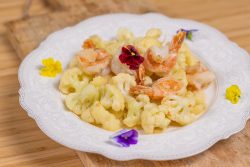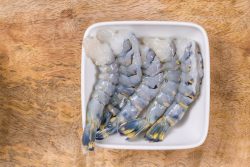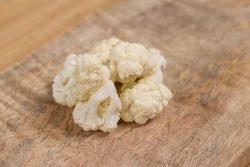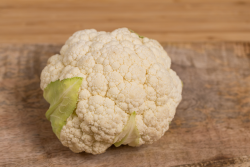Fried cauliflower with prawns 大蝦炒花椰菜(菜花 )

Fried Cauliflower with Prawns is a popular Chinese dish that combines two key ingredients: cauliflower and prawns (also known as shrimp). While I cannot provide the exact historical origins of this specific dish, I can provide some insights into the broader culinary traditions and influences that might have contributed to its creation.
Cauliflower itself is not native to China but was introduced to the country through trade and cultural exchange. It is believed to have originated in the Mediterranean region and was brought to China during the Ming Dynasty (1368-1644) or possibly earlier. Chinese cuisine has a long history of incorporating vegetables in various dishes, and cauliflower quickly found its place in the local culinary repertoire.
Prawns, on the other hand, are abundant in Chinese coastal regions, and seafood has always been an important part of Chinese cuisine. The consumption of prawns can be traced back to ancient times, and they have been featured in a wide variety of Chinese dishes throughout history.
The combination of cauliflower and prawns in a fried dish likely emerged as a result of the creative exploration and experimentation in Chinese kitchens. Chinese cuisine is known for its diverse cooking techniques, including stir-frying, deep-frying, and steaming. These techniques allow for the creation of flavorful and visually appealing dishes by combining different ingredients.
The popularity of the Fried Cauliflower with Prawns dish might have grown over time as it appealed to the Chinese palate, which appreciates a balance of flavors, textures, and visual presentation. It’s also worth noting that regional variations of this dish might exist, as different culinary traditions and local ingredients can influence its preparation.
Today, Fried Cauliflower with Prawns can be found in many Chinese restaurants around the world. It showcases the versatility of cauliflower and the succulent taste of prawns, offering a delightful combination of textures and flavors that have made it a beloved dish among both Chinese and non-Chinese diners.
While the precise history of Fried Cauliflower with Prawns remains unclear, its popularity and continued presence in Chinese cuisine are a testament to the rich culinary heritage of China and the ongoing innovation within its culinary traditions.
Fried cauliflower with prawns
200 gram cauliflower
5 prawn (around 100 grams)
Salt and Pepper
1 teaspoon corn powder
1/2 dl water to mix with the corn powder
4 tablespoons of vegetable oil for all the frying
3 gram ginger fine chopped
Fry cauliflower and prawns separately.
We choose to fry the prawns first, and afterwards we fry the raw cauliflower in the same oil so they absorbs the flavors together with the ginger.
When fried a few minutes add 2 dl water in the frying pan and let it simmer until the cauliflower is cooked. (About 4min)
The water left in the frying pan you can use for mixing with the teaspoon of corn starch.
Mix cauliflower and prawns and add the cornstarch water.
Dish is ready.
大蝦炒花椰菜(菜花 )
200 克花椰菜
5隻大蝦(約100克)
鹽和胡椒
1茶匙玉米粉
1/2 dl 水與玉米粉混合
4湯匙植物油炒蝦,炒花椰菜
3 克生薑,切碎
將花椰菜和蝦分開炒。
我們選擇先炒蝦,然後用同樣的油炒生花椰菜,讓它們和薑一起吸收味道。
將花椰菜炒幾分鐘後,在炒鍋中加入 2 分升水,然後用中火炒煮至花椰菜熟(大約四分鐘左右)
炒鍋中剩餘的汁可用於與一茶匙玉米澱粉混合。
將花椰菜和蝦稍微炒後加入玉米澱粉水。
菜就做好了。







